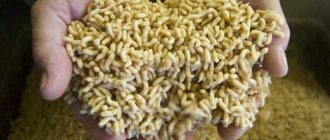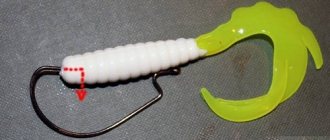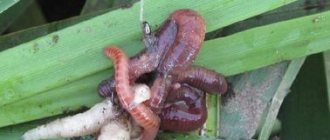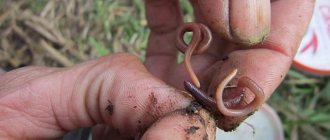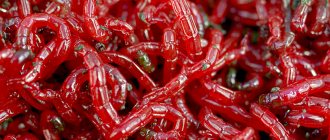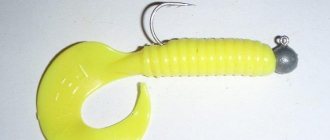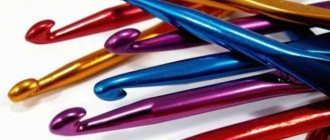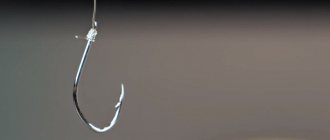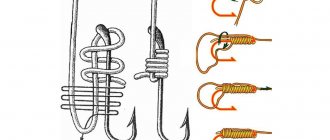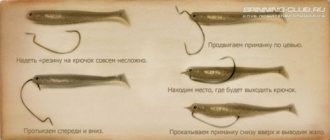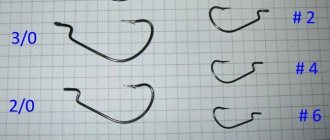The use of special tools will significantly simplify the process of knitting hair accessories.
7 minutes Author: Andrey Goryachev 0
- Basic principles of fishing with boilies
- Tools and materials for knitting rigs
- Hook selection
- The most catchy installations
- Video on the topic
Over the past twenty years, boilies have gained immense popularity and have become the main bait when fishing for trophy carp. To catch a worthy trophy, a carp angler must be able to correctly place boilies on a hook and know several options for installing hair equipment.
A special boilie needle has a fine notch at its end to pry up the hair when it is pulled through the boilie into the hole made. The boilie is pierced exactly along its central axis. The most famous installation method is hair fastening, when a ball or the required number of them is threaded and fixed onto a special piece of fishing line, which fishermen call hair. The hair itself is attached to the hook.
How to put a boilie on a hook in different ways
You can place boilies on a hook in several effective and not labor-intensive ways.
Important! Before baits are put on the equipment, they must have a hole, which is made with a special needle or thin awl.
A special boilie needle has a fine notch at its end to pry up the hair when it is pulled through the boilie into the hole made. The boilie is pierced exactly along its central axis. The most famous installation method is hair fastening, when a ball or the required number of them is threaded and fixed onto a special piece of fishing line, which fishermen call hair. The hair itself is attached to the hook.
There are modifications by which the hair is tied to the hook. The hair can be tied to the straight part of the hook fore-end, or you can connect the equipment at the very bend of the fore-end. Under certain fishing conditions, the bait is mounted on a leash in front of the hook. In this case, the hook must be tied to the fishing line after stringing the bait ball onto it, subsequently stopping the free movement along the fishing line at the required distance.
Small boilies, up to 0.8 centimeters in diameter, can be mounted directly on the hook. In this case, the hook tip must remain open. If there is no needle for puncture, the nozzle is mounted by making a full circular cut along the surface of the ball. The hair is knitted along the cut and in this form is attached to the hook of the equipment in the place required by the fishing conditions. This method is relevant for boilies of large diameters.
Addition: In fact, the short D-section itself does not play any role. Due to the rigid installation, which makes the fish perk up and rush away (being caught during this jerk), and the aggressive bending of the leader itself, there is no point in making a long section. The short one copes with a bang, but only if the two conditions mentioned above are met.
How to plant a boilie
The boilie is mounted on the tackle in several ways:
- the loop on the hair is threaded through the ball and locked;
- a circular cut is made on the ball, a loop of elongated hair is tightened along it;
- a fastener with a ring is mounted into the dough ball: metal, plastic, with a thread, after which the ball is mounted to a loop or on the shank of a hook (for d-bait);
- An elastic band is mounted on the nozzle and attached directly to the hook or hair (for mini boilies or pellets for crucian carp, roach, carp, preferably oblong).
A common method is installation with a stopper. For it you will need:
- mounting needle or mounting hook (the notched tip of the tool is closed with a hinged latch);
- a regular crochet hook of the smallest size;
- drill for boilies (thin drill on the handle, used for fragile boilies: dusty, floating);
- a stopper, a special silicone one (buy in a store) or a stick (match, twig, straw).
The boilie attachment on the hair looks like this:
- pierce the ball with a needle along the central axis (if the ball is fragile, pre-drill a hole with a drill);
- hook a loop of hair with the notch of the needle and pull it through the ball;
- secure the loop with a stopper so that the ball does not fly off when casting (in a tight bait test, the loop knot already serves as an excellent lock);
- You can throw it in - the installation is ready.
Use the most reliable and strong fishing gear, except for the feeder. The fishing line of a regular donkey should be at least 0.5 mm. Fishing for a large fish weighing 5 kilograms will bring you real pleasure and it will be a great pity if you are let down by fragile cheap tackle.
pricormi.ru
Example #4 - Ring on Shank
When to use: Best with a pop-up. With a sinking boilie, the efficiency will be noticeably lower
So, there are many variations of the ring on the forend, but the meaning is the same - replacing a hair. It cannot be said that this rig is the most catchy, but you need to have it in stock in order to sometimes offer the fish something extraordinary.
[THERE IS AN ANSWER] Which fishing rod is best for carp fishing
Rating: 4 out of 5
Despite the wide range of boilies in specialized stores, most fishermen prefer to use homemade balls as bait. In this case, you can achieve the ideal combination of mixture components, suitable for a certain type of fish and the characteristics of the reservoir.
Groundbait boilies
Boilies were invented specifically for carp fishing and are designed for its ability to suck up any bulk food. They were originally supposed to be strung on a hook, hiding its sting in the body of the bait. But over time, fishermen improved the existing gear, coming up with several alternative options.
Before attaching a boilie, you should select the correct type of bait installation on the hook, depending on the type of fish and the characteristics of the reservoir. Today, the most popular and effective way of rigging is “hair”. This method is best suited for catching large fish such as carp and bream. It consists in the fact that the boilie is attached not to the hook itself, but to the branch from the leash located next to it.
In the modern fishing world, both experienced carp fishermen and beginners who like to spend a day on the shore with bottom gear cannot do without boilies. Fishermen know various baits made from potatoes, porridge, dough, corn, but boilies are still one of the best, because they perfectly seduce fish.
Practical recommendations
There are various fishing techniques. You need to know the topography and depth of the reservoir, what time the fish feed, and what they eat. You can catch weighty specimens if you follow the basic rules:
- Suitable odor enhancers should be selected.
- In spring, carp love proteins, and in summer – carbohydrates.
- Soluble boilies are used for bait.
- Insoluble balls are used as bait.
- It is preferable to experiment with multi-colored balls.
- For muddy ponds with muddy bottoms, you need to choose floating baits.
- The size of the hook is selected according to the size of the boilie.
A fine drill bit will not destroy the bait while piercing. To quickly tie a boilie like experienced fishermen, you should practice.
How to attach boilies to tackle?
After the first three stages, namely choosing a reservoir, preparing boilies and tackle, it remains to understand exactly how to tie boilies onto the tackle. Using a thin needle, make a hole in the dough bait, and then attach it to the leader that you previously attached to the main fishing line.
Important! Do not attach the boilie to the hook, this will scare away the carp!
Carp is a very cunning fish that will immediately understand what is happening. The subtlety of preparing boilies is that the leash should descend approximately from the center of the hook shank. To do this, pass it through a cambric pre-installed on the hook. This will double the reliability of hooking fish. The length of the leash should be twice as long as the length of the boilie itself.
A beginner in fishing can easily figure out how to knit boilies and then apply this technology in practice. It is important to remember that for fish of the carp family, first of all, it is not the color or smell of the proposed bait, but its nutritional value. The carp will immediately understand that this food will not satisfy it and therefore simply will not touch it. The ingredients for the boilie should be saturated with fats, proteins and carbohydrates.
However, if your goal is short-term success, flavorings are also suitable. Over time, the fish will get used to your new baits and in the future you will always leave the pond satisfied after using tackle with boilies.
Having familiarized yourself with the technique of knitting boilies, feel free to take on practical classes to consolidate the skills you have acquired. Boilies for carp fishing are versatile and valuable equipment for both experienced fisherman and beginners.
The hook is selected in proportion to the boilie, single, made of thick and reinforced wire, well sharpened, with a shortened fore-end.
Boilies are sold in special stores of different types, sizes, tastes and colors. There are also many different companies, the quality of the product itself and the price category. But some fishermen prefer to make them themselves at home.
Binding components can be chicken or quail eggs, honey, gelatin, wheat gluten, corn syrup, beet molasses, etc. Some of them have a good smell.
[THERE IS AN ANSWER] How to choose a carp rod for long casting
Natural products can also act as odor enhancers, for example, fish oil, vanillin, essential oil extracts and a variety of aromatic spices. For plasticity, glycerin, fruit syrups, and honey are used.
The main components in the preparation of boilies are flour, eggs, crushed cereal, food coloring and flavor enhancers.
Cooking steps:
- The eggs and liquid ingredients are mixed well, separate from the dry ingredients.
- Everything is combined and mixed into the dough. Eggs can be added until the dough becomes elastic. dense and it should not stick to your hands.
- We form sausages from the dough, which we cut into small pieces of the required boilie diameter.
- Heat treatment, cooking, microwave or freezing is everyone's choice. but you also need to take into account some nuances, such as cooked boilies become loose, become limp faster and hold their shape less, and can also float.
The hard bait is attached to the shank of the hook. This equipment is universal.
Cooking boilies
Boilies are sold in special stores of different types, sizes, tastes and colors. There are also many different companies, the quality of the product itself and the price category. But some fishermen prefer to make them themselves at home.
Binding components can be chicken or quail eggs, honey, gelatin, wheat gluten, corn syrup, beet molasses, etc. Some of them have a good smell.
Natural products can also act as odor enhancers, for example, fish oil, vanillin, essential oil extracts and a variety of aromatic spices. For plasticity, glycerin, fruit syrups, and honey are used.
The main components in the preparation of boilies are flour, eggs, crushed cereal, food coloring and flavor enhancers.
Cooking steps:
- The eggs and liquid ingredients are mixed well, separate from the dry ingredients.
- Everything is combined and mixed into the dough. Eggs can be added until the dough becomes elastic. dense and it should not stick to your hands.
- We form sausages from the dough, which we cut into small pieces of the required boilie diameter.
- Heat treatment, cooking, microwave or freezing is everyone's choice. but you also need to take into account some nuances, such as cooked boilies become loose, become limp faster and hold their shape less, and can also float.
How to attach a boilie with a hair rig?
Hair equipment has several varieties:
Knotless installation is the most popular, as it does not require additional devices.
The mechanism is made in this way:
- That a thin fishing line is attached at one end to the wiring using a double knot, and at the other end it is attracted to the eye of the hook.
- Thus, the length of the hair is reduced to 1.5 - 2 centimeters. This segment must be attached to the hook using a ring.
- Make a small tunnel in the bait using a needle or awl.
- Secure the ball in a special silicone stopper using a hair.
D-Equipment is distinguished by the length of the fishing line, which increases in size. This distance increases the likelihood of self-cutting.
The hard bait is attached to the shank of the hook. This equipment is universal.
Boyle at home
Attaching the ball to the hook and hair
There are different attachments for baits, some of them are labor intensive, but they provide benefits. How to tie boilies effectively:
- The bait made at home is fixed to the hair with a cambric, which is mounted to the eye of the hook. A spring is attached to the other end of the thread and a ball is formed.
- A loop is made at one edge of the hair, inserted into the shank of the hook from the point side, then the thread is tied in a knot, and the excess is cut off. A hole is made in the ball with an awl or a needle and a hair is passed through, secured with a stopper.
- Homemade boilies are installed on the forend of the hook and secured with a spring. That is, the bait itself will be located near the head of the hook. Therefore, the bait is threaded through the top, and then the ring is tied to the fishing line. Store-bought balls that are too hard can damage the fore-end when inserting the boilie.
There are other options for attaching attachments, but these are the most popular and understandable for novice anglers.
Place the boilie on the hook
Catching carp with boilies
At what distance from the hook is the boilie attached?
The length of the hair is calculated approximately like this: for an 8 mm boilie its length should be at least 2 cm, and for a 16 mm boilie - 4 cm. An excellent option is to take the thinnest hair from a braided line, i.e. 0.05-0.07 mm in diameter. However, then it must have a separate fastening, since a leash of such a diameter will be clearly weak.
Boilies are divided into two types: sinking and floating. The boilie can also be adjusted using pellets, setting the desired depth.
When preparing for fishing with boilies, regardless of the chosen gear, you must consider that:
Installing a boilie on a hook
Installation of hair equipment can be different, depending on the imagination of the fisherman. Its most common types are:
Knotless installation is the simplest and most popular equipment without the use of additional devices.
“Blow Back” is an equipment that has several installation options. Its design allows for the hook to be deeper into the lips of the fish when trying to get rid of it. One of the options for such equipment is the “butterfly”, in which two halves of the same or different boilies are installed on the “hair” with their convex sides facing each other.
Blow Back Rig Photo source: www.anglingiron.co.uk
The D-Rig boilie rig is one of the most effective mounting schemes, in which the boilie with the hook has the greatest range of motion when trying to spit it out.
D-Rig attachment for attaching boilies to hooks
Hard rig is a type of rig in which the boilie is in close proximity to the hook.
Hard hair equipment for boilies
In order to understand the basic principles of installing hair equipment, it is enough to study the knotless technique of knitting equipment, which every self-respecting carp hunter should know. The algorithm for its creation includes the following steps:
- A loop is knitted at the end of the leash with a simple knot;
- The other end of the leash is threaded through the eye of the hook and pulled to the optimal length of the “hair” (the end of the leash with the loop). This value is selected individually depending on the size of the boilie or the preferences of the angler. Most often it does not exceed 15 mm;
- The free end of the leash is wrapped around the hook with the “hair” (minimum 7 turns);
- The end of the leash is passed through the eye, tightening the knot;
[THERE IS AN ANSWER] How to catch carp with boilies in a pond
To fix the boilie on the “hair loop” of the leash, use a special hand drill and a broaching needle with a hook. Using the first one, the boilie is drilled through. A needle with a hook is inserted into the hole formed so that the hook comes out from the back side. Next, the loop of the leash is hooked and pulled through the hole. A silicone boilie stopper is inserted into the extended loop for fixation.
The sizes of the baits themselves can also be quite different, 5-30 mm. Small boilies are used more often for hunting carp that are too cautious or not very active. Large baits are good because their use eliminates the unnecessary bite of small fish. In addition, you can always make a smaller bait from a large boilie by simply cutting the bait in half.
Placing the boilie on the hook itself
The boilie can be placed directly on the hook itself, that is, on its shank. It is held in place by a spring attached to the bottom of the hook. This method is only possible with homemade boilies, since a store-bought one simply cannot be pierced with a fishing hook. It’s not entirely correct to use it, but some fishermen still use this method.
Bandage tape
The boilie can be attached to the hook using bandage tape.
It is attached to a hook or an auxiliary D ring, which is attached to the shank of the hook using a Knotless knot.
Thread the ribbon through the boilie using a needle and install the stopper. The tape is made of latex, thanks to this the boilie is attached tightly to the hook.
Algorithm for tying a ribbon: take a latex ring, thread one end of it into the D ring and then thread it into the loop of the latex ring itself, tighten the resulting knot.
Now we have the free end of a closed, double-folded tape. We thread this free end into the boilie and install a stopper.
Bandage thread
Here, a bandage thread is used as fastening. It is made of silicone, just like the tape. Very durable, but also stretches very well. It is attached to the hook thanks to an auxiliary ring; you need to tie it to it with a Knotless knot.
The remaining steps for putting on the boilie are the same as with hair mounting. Only the boilie should fit snugly to the handle.
KNOTLESS KNOT
Surgical loop:
- fold the end of the fishing line in half;
- make a loose loop and thread the folded end through it several times;
- Do not fully tighten the knot;
- Wet the line in the area of the knot and tighten it completely.
Perfect Loop Knot:
- Tighten the knot after wetting the fishing line.
- Pass the top loop through the bottom loop;
- Run the free end of the fishing line between the resulting loops without tightening;
- We make a loop again repeating the first point, placing it on top of the first loop;
- Make a loop by passing the free end under the fishing line;
- The long end of the hair is wrapped around the shank of the hook at least seven times.
- Next, thread the long end into the eye of the hook.
- All that remains is to tighten the knot.
How to attach mini boilies to a hook?
Mini boilies differ from regular boilies in size, and therefore hooking will have its own nuances:
- Selecting a hook according to the size of the boilie is a mandatory rule.
- To bait a spot, mini boilies are thrown using a “bait spoon” for a close distance, and for a long distance using a “rocket”.
- In order to avoid catching small fish, you can cheat by improving the design of the bait. Instead of one mini, tie several pieces of hair with boilies. For such a harness, a Rig-Ring is used.
- Mini boilies are carefully drilled with the thinnest drill.
How to attach boilies so that they do not fall apart when casting and fishing in the current:
- Firstly, pierce the boilie strictly in the middle.
- Secondly, it should not be loose in consistency.
- Thirdly, calculate the hair length correctly. If the boilie is about a centimeter wide, the length of the hair is two centimeters, or the width of the boilie is about 1.5 centimeters, then the length of the hair is 4 centimeters.
- Fourthly, use only a specially designed needle to pierce the boilie.
- Fifthly, use the correct method to attach the boilie, and not on the hook itself.
This article contains all the information not only about what a boilie is, but its installation, preparation, varieties, knot technique. And not only a beginner in fishing, but also an experienced fisherman will receive information from it.
Having mastered the technique of fishing with boilies, you can catch not small carp, but large trophy ones. There will be photographs and impressions of such fishing that will last a lifetime.
Quick tips:
- To feed the fishing spot, use instant boilies.
- For main bait, use insoluble boilies.
- Use sinking boilies in clean reservoirs where the bottom is sand or gravel.
- Floating boilies are recommended for use in reservoirs with muddy water and muddy bottom.
- Don't be afraid to experiment with flavors. Carps are smart and curious; they will get used to one taste and remember that it is dangerous. And a new unknown scent will outwit them 100%.
- Use colorful boilies. The main thing is that they do not match the color of the natural cyprinid zone.
- If you prepare boilies yourself, remember that cooking in the microwave makes their consistency more loose. Such boilies will lose their shape faster in water. Than those that were boiled.
- Depending on the carp fishing season, the composition of the boilies changes. Rich in carbon in summer, rich in protein in autumn and spring.
- In order for homemade boilies to last longer, they must first be boiled and then frozen.
- boilies are attached to the hook using hair, bandage tape and bandage thread.
- The length of the hair, as well as the size of the hook, depends on the diameter of the boilie.
- When tightening any knots on the line, do not forget to wet it in order to reduce heat at the point of friction.
- Mini boilies are thrown with a “bait spoon” for close distances, and for long distances a “rocket” is used, but not a “cobra”.
- By using mini boilies when fishing, you can improve the design to several hairs per hook.
- If you cannot pierce the boilie, then simply drill it with the thinnest drill.
- To pierce the boilie, it is better to use a special needle with a hook.
fastcarp.ru
Hooks for catching carp with boilies
The size of the hooks may vary, depending on the size of the boilies and the desired catch. When choosing hooks, you need to pay attention to the strength and sharpness of the products.
In most cases, carp are hooked on their own, and therefore the fleshy jaw breaks through not after a strong hook, but under the weight of the fish itself. That is why the hook must be very sharp and reliable.
The best option is forged hooks with a short shank. Ideally, the distance from the shank of the hook to its sting should be approximately 1/3 or 1/2 the size of the boilie.
Carp boilies are attached using a hairline to a carp
and they don’t hold up well on it, but most importantly,
boilies for carp are excellent at luring prey. Catching carp with boilies is also good because having a powerful mouth, only carp can bite through the boilie, which means other fish are not interested in it.
Equipment for catching carp with boilies
Carp equipment for fishing with boilies is the basis for success in fishing. The second component will, of course, be the recipe for making boilies. Although some carp fishing enthusiasts may prioritize in the reverse order. But, you yourself understand that from rearranging the terms..., and so on, according to the text of the saying. Therefore, let's consider both components in more detail.
Tackle for catching carp with boilies, as a rule, consists of a leash with a hook and a hair rig that serves to secure the boilie - that is, a ball of dough prepared according to a special recipe with additives, which will be discussed below.
The most common gear used for fishing in almost all regions is the installation, in which the hair equipment for the boilie is tied directly to the hook.
This is the easiest installation method, but pay attention to these little things:
- The leash should come out of the eye of the hook on the inside of the bend, then the hooking of the tackle will be better.
- Do not start wrapping from the side where the eye ring adjoins the hook; the leash in this place can quickly rub against the sharp edge of the ring.
Fishing can be no less catchy with a “reverse strike” tackle, which is also very common and has many other names, but its mechanism remains unchanged.
The point is that when the carp tries to free itself from the bait, the tackle “hits back” with its sliding part on the eye of the hook, due to which the hook penetrates more deeply into the lip of the hooked carp.
Making this equipment is somewhat more complicated, since it requires making a metal ring that will slide along the shank of the hook. A hair leash for a boilie is attached to the eye of the hook, passed through a ring placed on the shank, and tied to this ring.
The shank of the hook should be arched, that is, slightly bent inward.
The “Multi Rig” has proven itself well, in which the boilie moves in the opposite direction when the carp tries to spit it out or suck it in. In this rig, the hair leash is attached in the form of a loop, and the boilie, with the help of a ring, moves along this loop.
Fishing for carp with rigid rigs has proven itself in those reservoirs where other carp anglers use various braided rigs. For a rigid rig, it is necessary to attach a hair leash to the eye of the hook and pass it through a tube placed on the shank of the hook; the tube must be made of a material that can well fix the hair leash.
The equipment is effective for both pop-up and bottom boilies. Due to the rigidity of the equipment, the carp cannot spit it out.
How to attach boilies to a hook
There are two ways to properly tie boilies to a hook. In most cases, one or more boilies are attached to the line allowance , which remains after we have tied the hook to the leash. This line allowance is called hair . The required hair length is determined by the size of the hook and the diameter of the boilies, as well as their number.
For a good hook on the fore-end, it is necessary to wear a cambric about one and a half centimeters long, with the hair leaving the hook approximately in the middle of the fore-end. Accordingly, before tying the hook, you need to put the cambric on the leash, and then tie the hook. After tying the hook, we make a loop at the end of the hair as a stopper. Then slide the hook onto the fore-end. The hair should be approximately four centimeters long when attaching one boilie, which has a diameter of sixteen millimeters.
also attach boilies to the hook in this way: tie a hair strung with one or more boilies and secured with a stopper to the shank of the hook at the bend.
can also around the circumference of the boilie with a thin blade and clamp the hair in the form of a loop in this cut. For this method of attaching a boilie, a stopper and a needle are not needed.
